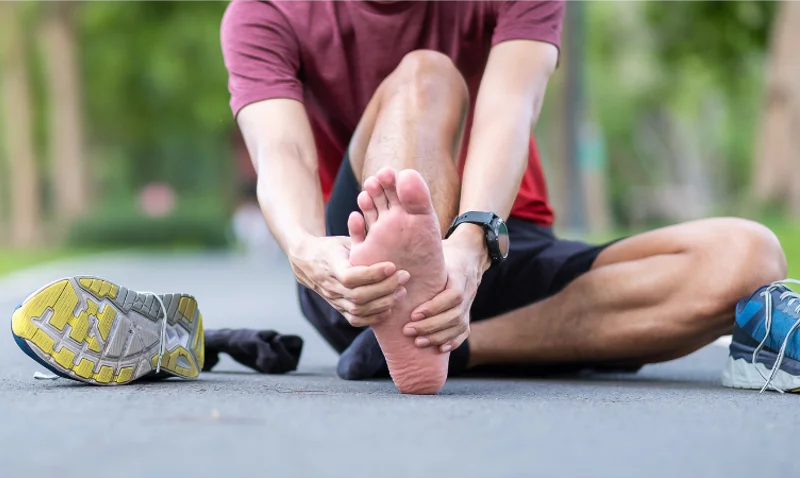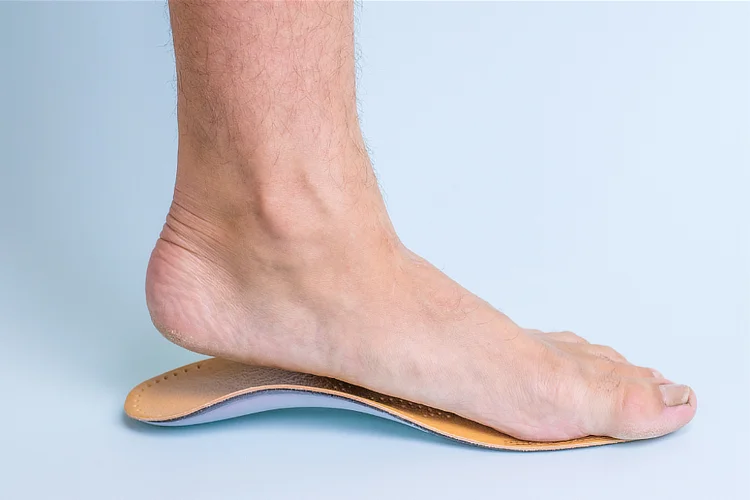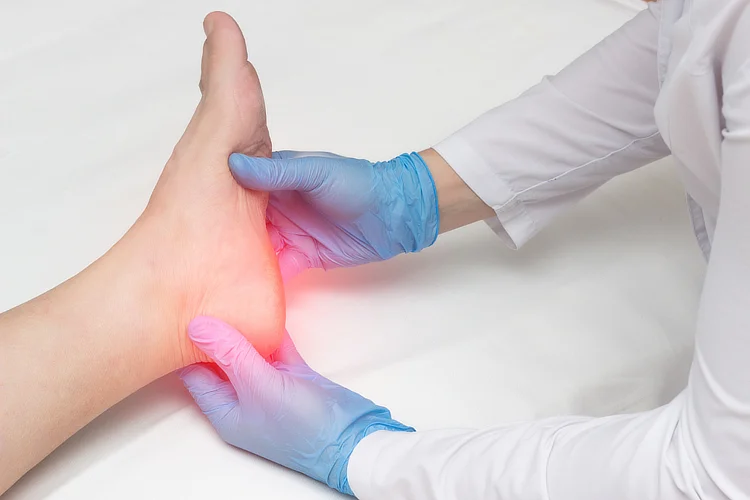Plantar Fasciitis Treatment in Singapore: Managing Heel Pain Effectively
Plantar fasciitis causes heel pain due to strain on the plantar fascia. Dr Foo provides targeted treatments and tailored care to relieve pain, support healing, and restore foot function.
MBBS (University of London) | MMed (Ortho) | FRCSEd (Ortho) | FAMS (Ortho)



What Is Plantar Fasciitis?
Plantar fasciitis occurs when the plantar fascia, a thick band of tissue supporting the arch
of the foot, becomes inflamed due to excessive strain. It is a common cause
of heel pain, particularly among individuals who engage in prolonged standing, walking, or
high-impact sports. It. If left untreated, the condition can worsen, leading to chronic
discomfort and mobility issues.
At Apex Sports Clinic, we provide comprehensive plantar fasciitis treatment in Singapore,
offering tailored solutions tailored to your needs.

Plantar Fasciitis Causes
Plantar fasciitis typically develops due to repetitive stress and overuse of the plantar fascia. Several factors can increase the risk of developing this condition, including:
- Excessive Physical Activity – High-impact activities such as running, jumping, or prolonged standing can place excessive strain on the plantar fascia.
- Improper Footwear – Shoes with inadequate arch support or cushioning can disrupt foot mechanics and contribute to heel pain.
- Foot Structure – Flat feet, high arches, or an abnormal gait can alter weight distribution and increase tension in the fascia.
- Obesity or Sudden Weight Gain – Excess weight places additional pressure on the heel and foot arch.
- Ageing – The plantar fascia loses elasticity with age, making it more prone to injury.
- Occupational Hazards – Jobs requiring long hours of standing or walking can increase the risk of plantar fasciitis.
Common Symptoms of Plantar Fasciitis
Patients with plantar fasciitis often experience the following symptoms, although the severity and progression can vary among individuals:
- Sharp, stabbing pain in the heel, particularly with the first steps in the morning or after periods of rest.
- Increased pain after prolonged standing or sitting, especially on hard surfaces.
- Pain that worsens after exercise but may not necessarily occur during physical activity.
- Tenderness at the bottom of the heel, especially when pressing on the affected area.
- Stiffness and tightness in the foot arch, which can limit mobility.
If left untreated, symptoms can worsen over time, potentially leading to chronic pain and impaired daily activities.

Diagnosing Plantar Fasciitis
Diagnosing plantar fasciitis typically involves a clinical evaluation, physical examination, and imaging tests if necessary.
- Medical History & Symptom Assessment – Review of symptoms, activity levels, and lifestyle habits to identify patterns of heel pain and possible causes, such as increased activity or prolonged standing.
- Physical Examination – Assessing pain points, tenderness along the arch, foot structure, flexibility, walking patterns, and range of motion to check for gait abnormalities. The windlass test may also be performed to assess plantar fascia function by observing pain or tightness when the toes are passively dorsiflexed.
-
Diagnostic Imaging – Imaging tests may be used to rule out other
conditions like stress fractures or nerve compression:
- Ultrasound: Visualises plantar fascia thickness and detects signs of inflammation.
- X-ray: Identifies heel spurs or bone abnormalities.
- MRI: Used for persistent or atypical cases to assess soft tissue damage.
Early diagnosis helps guide effective treatment and prevent chronic complications that can affect your long-term mobility.
Plantar Fasciitis Treatment Options
The treatment for plantar fasciitis focuses on alleviating pain, reducing inflammation, and promoting healing. A combination of conservative measures, medical interventions, and rehabilitation exercises can be effective in managing the condition. Surgical intervention is rarely required for plantar fasciitis but may be considered in severe cases that do not respond to conservative treatments.
| Treatment Type | Purpose |
|---|---|
| Conservative (Non-Surgical) Treatments | |
| Rest and Activity Modification | Reduces strain on the plantar fascia by limiting activities such as prolonged standing, walking on hard surfaces, or high-impact exercise. |
| Footwear, Orthotics and Splints | Supportive shoes with good arch support and cushioning help reduce heel pain. Custom orthotic insoles evenly distribute pressure across the foot, while night splints maintain a gentle stretch during sleep to prevent morning stiffness. |
| Stretching and Strengthening Exercises | Regular stretching exercises improve flexibility and relieve plantar fascia tension. These include calf stretches to loosen the lower leg muscles, toe stretches to improve mobility, plantar fascia rolling with a frozen water bottle, and towel scrunches to strengthen foot muscles. |
| Cold Therapy and Massage | Applying ice packs for 15 to 20 minutes several times a day helps reduce inflammation. Deep tissue massage of the foot arch can also relieve muscle tension. |
| Pain Management | Non-steroidal anti-inflammatory drugs (NSAIDs) help reduce pain and inflammation. Topical anti-inflammatory creams may provide additional relief for pain in specific areas. |
| Medical and Advanced Therapies | |
| Shockwave Therapy | Non-invasive sound waves stimulate tissue repair by promoting increased blood flow and cellular regeneration. Commonly used for chronic plantar fasciitis. |
| Corticosteroid Injections | Direct injection of corticosteroids into the plantar fascia to help reduce inflammation and pain. However, repeated injections are generally discouraged to avoid tissue weakening. |
| Platelet-Rich Plasma (PRP) Therapy | Involves injecting concentrated platelets from the patient’s blood into the affected tissue to promote healing and reduce inflammation. |
| Surgical Intervention | |
| Plantar Fascia Release Surgery | A surgical procedure that partially releases the plantar fascia ligament to reduce tension and relieve chronic pain. It can be performed endoscopically or through open surgery, depending on the complexity of the case. |

Preventing Plantar Fasciitis Recurrence
To prevent plantar fasciitis from returning, it is important to maintain good foot health and proper movement patterns. Key preventive measures include:
- Wearing appropriate footwear with good arch support and cushioning.
- Stretching regularly to keep the foot and calf muscles flexible.
- Avoiding prolonged standing or high-impact activities on hard surfaces.
- Using orthotic insoles if you have flat feet or high arches.
- Maintaining a healthy weight to reduce excess strain on your feet.
Every patient deserves a treatment plan tailored to their needs. We start with non-surgical approaches before considering more invasive interventions.
Where to Find Plantar Fasciitis Treatment in Singapore?
Apex Novena
admin@apexsportsclinic.sg
101 Irrawaddy Rd, #18-12 Royal Square Medical Centre, Singapore 329565
Nearest MRT: NS20 Novena
Apex East Coast
admin@apexsportsclinic.sg
112 E Coast Rd, #03-03/04 i12 Katong, Singapore 428802
Nearest MRT: TE26 Marine Parade
Why Do Patients Choose Apex Sports Clinic?
Sports Doctor in Singapore: Personalised & Affordable Care
Progressive Treatment Philosophy
We prioritise personalised, non-invasive solutions, progressing to specialised treatments, including surgery, only when needed for more effective and targeted care.
Holistic Patient-Centred Care
From diagnosis to rehabilitation, we provide comprehensive and seamless care for a wide range of orthopaedic conditions.
Specialist in Sports Orthopaedics & Injury Management
We combine expert injury management with a proactive approach to maintaining your body’s strength and function, so you can recover fully and perform at your peak.
Patient Journey
1 . Schedule Your Appointment

2 . Expert Diagnosis & Consultation

3 . Customised Treatment Plan

Schedule an Appointment

Our Insurance Partners






Frequently Asked Questions (FAQs)
It is unlikely to cure plantar fasciitis in one week, as the condition typically requires weeks or months of consistent treatment. However, you can alleviate symptoms with rest, ice application, stretching exercises, proper footwear, and anti-inflammatory medications. Early intervention with these measures may reduce discomfort, but full recovery depends on factors like severity and adherence to treatment. It is advisable to consult a doctor or physiotherapist for a tailored treatment plan.
Plantar fasciitis is referred to as "足底筋膜炎" (zú dǐ jīn mó yán) in Chinese. It describes the inflammation or degeneration of the plantar fascia, the thick tissue band along the bottom of the foot that supports the arch and absorbs shock during movement.
The best shoes for plantar fasciitis are those with good arch support, cushioning, and a firm heel counter to reduce strain on the plantar fascia. Shoes with a slight heel lift can also help reduce tension in the Achilles tendon and plantar fascia. It is recommended to consult a specialist or podiatrist to find footwear suited to your foot structure and activity level.
Plantar fasciitis is pronounced "PLAN-tar fash-ee-EYE-tis". The term refers to the inflammation or degeneration of the plantar fascia, a tissue band that runs along the bottom of the foot and supports the arch.
Plantar fasciitis taping involves applying athletic tape to the foot to provide additional support to the plantar fascia, reduce strain, and alleviate heel pain. Techniques like low-dye or kinesiology taping can help redistribute pressure during walking or standing. While taping can provide temporary relief, it is typically used alongside other treatments such as stretching exercises and orthotics.
Running with plantar fasciitis is generally discouraged, as it can worsen symptoms and delay recovery. High-impact activities place additional strain on the inflamed tissue, potentially causing further damage. If running is essential, consider reducing intensity, using proper footwear, and incorporating low-impact cross-training. It is advisable to consult a sports doctor or physiotherapist to assess your condition and provide tailored guidance.
Eccentric stretching for plantar fasciitis involves lengthening the calf muscles and plantar fascia under tension, usually by lowering the heel from an elevated position. This controlled stretching improves tissue strength, reduces tightness, and promotes healing by encouraging collagen realignment. It is often included in rehabilitation protocols to manage chronic plantar fasciitis.
Heel spurs are bony growths that develop on the underside of the heel bone due to prolonged stress on the plantar fascia. Plantar fasciitis, on the other hand, is the inflammation or degeneration of the plantar fascia tissue. While these conditions can occur together, not everyone with plantar fasciitis has a heel spur, and not all heel spurs cause pain. A doctor or specialist can use imaging tests to distinguish between the two for a proper diagnosis.
Plantar fasciitis socks can be worn during the day for activity support or overnight to maintain gentle foot stretch. Night socks are typically worn while sleeping to reduce morning stiffness, while daytime compression socks may be used during prolonged standing or walking. The duration of use depends on individual symptoms and comfort. If you are unsure, it is recommended to seek advice from a healthcare professional like a sports doctor or physiotherapist for personalised guidance.
Yes, massaging plantar fasciitis can help relieve heel pain by improving blood flow, reducing muscle tension, and breaking down adhesions in the plantar fascia. Techniques like deep tissue massage and plantar fascia rolling with a frozen water bottle are commonly used to ease discomfort and promote healing. However, massage alone may not address the underlying cause of the condition, so it is advisable to consult a healthcare professional like a sports doctor or physiotherapist for a comprehensive treatment plan.
To use a foot roller for plantar fasciitis, place the roller on the floor and gently roll your foot back and forth over it while applying light to moderate pressure, focusing on the arch. This helps stretch the plantar fascia, improve circulation, and reduce inflammation. For best results, use the roller for 5 to 10 minutes daily, especially after periods of inactivity. If you experience persistent pain, it is recommended to consult a physiotherapist or sports doctor for tailored treatment.
Magnesium may help with plantar fasciitis if muscle tightness or cramping contributes to the condition, as the mineral plays a role in muscle relaxation and nerve function. However, research directly linking magnesium supplementation to improved plantar fasciitis outcomes is limited. It is advisable to consult a doctor or specialist before starting supplements, especially if you have underlying medical conditions.
Arcoxia (etoricoxib) is a prescription non-steroidal anti-inflammatory drug (NSAID) that may help reduce inflammation and pain associated with plantar fasciitis. While it can provide short-term relief, it does not address the underlying movement-related causes of the condition. Long-term or frequent use of NSAIDs, including Arcoxia, may lead to side effects such as gastrointestinal discomfort, cardiovascular risks, or kidney issues. It is recommended to consult a doctor or specialist to determine if Arcoxia is suitable for your condition.
Treatment for plantar fasciitis typically involves a combination of stretching exercises, activity modification, orthotic support, and anti-inflammatory measures. Conservative therapies like plantar fascia and calf stretches can often be effective, while advanced options like shockwave therapy or platelet-rich plasma (PRP) injections may be considered for chronic or recalcitrant cases. It is best to consult a healthcare professional like a sports doctor or physiotherapist for a treatment plan tailored to your condition.
Cycling generally does not aggravate plantar fasciitis, as it is a low-impact activity that avoids excessive strain on the plantar fascia. However, improper cycling form, poor foot positioning, or overuse can still trigger discomfort. Adjusting seat height, using proper footwear, and limiting prolonged cycling can help reduce strain. If pain persists, it is advisable to consult a sports doctor or physiotherapist.
Exercises for plantar fasciitis heel pain often include plantar fascia stretches, calf stretches, and strengthening exercises for the foot muscles. Common routines involve stretching the plantar fascia by pulling the toes upward, performing wall calf stretches, and doing towel scrunches to strengthen the foot arch. Regularly performing these exercises can improve flexibility and reduce pain. It is recommended to consult a sports doctor or physiotherapist for a personalised exercise programme to treat your condition.
Inner knee pain and plantar fasciitis are not directly related but can coexist due to altered gait patterns or alignment-related biomechanical imbalances. Foot issues like flat feet or overpronation may shift the body’s alignment, causing knee strain. Addressing plantar fasciitis through stretching, orthotics, and strengthening exercises can sometimes reduce associated knee discomfort. It is advisable to consult a healthcare professional if symptoms persist.
A plantar fasciitis brace, often called a night splint, is a device designed to keep the foot in a dorsiflexed position while sleeping, gently stretching the plantar fascia and Achilles tendon. This prolonged stretch helps reduce morning heel pain and stiffness. While braces can provide symptom relief, they are most effective when used alongside stretching exercises and other conservative treatments.
The plantar fasciitis special test typically refers to the windlass test, where a healthcare professional, such as a physiotherapist or sports doctor, gently bends the toes upward while the patient is standing or sitting. A positive result is indicated by pain or tightness in the plantar fascia, especially near the heel. This test helps differentiate plantar fasciitis from other causes of heel pain and is commonly used during clinical evaluations.
Plantar fasciitis trigger points are sensitive areas within the plantar fascia, usually near the heel or along the arch, where muscle tightness or tissue adhesions cause localised pain. These trigger points often develop from repetitive strain or movement imbalances. Targeted massage, stretching, and myofascial release techniques can help alleviate discomfort.
Stem cell injections for plantar fasciitis involve injecting stem cells, often derived from the patient’s bone marrow or adipose tissue, into the plantar fascia to promote tissue regeneration. While preliminary research suggests potential benefits in reducing chronic inflammation and promoting healing, evidence remains limited, and the treatment is not yet widely adopted. It is advisable to consult an orthopaedic specialist to discuss available treatment options and their potential outcomes.
The fastest way to heal a plantar fascia tear involves early intervention with rest, immobilisation, and anti-inflammatory measures to reduce strain on the affected tissue. Stretching exercises, custom orthotics, and physical therapy can aid recovery, while advanced treatments like platelet-rich plasma (PRP) injections or shockwave therapy may help more severe cases. If you suspect a tear or experience significant pain, it is advisable to consult a foot specialist for a personalised treatment plan.
Plantar fasciitis typically takes several weeks to a few months to heal with appropriate treatment. Most individuals experience significant improvement within 6 to 12 weeks with conservative therapies, while chronic cases may persist for 6 to 12 months or longer. Factors such as adherence to treatment, activity levels, and underlying foot mechanics can influence recovery time. It is advisable to consult a healthcare professional like a sports doctor or orthopaedic specialist if symptoms persist.
With plantar fasciitis, it is best to avoid high-impact activities like running, jumping, and prolonged walking, especially on hard surfaces, as these can exacerbate symptoms. Exercises that place excessive strain on the plantar fascia, such as toe raises or improper calf stretches, should also be limited during the healing phase. It is advisable to consult a sports doctor or physiotherapist for guidance on suitable exercises that promote recovery without causing further irritation.
Plantar fasciitis may go away on its own in some cases, but the recovery process can take months or even years if left untreated. Early intervention with stretching exercises, activity modification, and proper footwear can significantly reduce symptoms and prevent chronic complications. It is advisable to consult a healthcare professional like a sports doctor or physiotherapist if heel pain persists or affects daily activities.
To massage plantar fasciitis, apply firm but gentle pressure along the arch of the foot using your thumbs or a massage ball. Rolling a frozen water bottle under the foot can also help reduce inflammation and relax the plantar fascia. Focus on the heel and arch for 5 to 10 minutes, particularly after activity. It is advisable to consult a sports doctor or physiotherapist for personalised guidance or if discomfort worsens during or after massage.
Plantar fasciitis is likely healing when heel pain gradually decreases, especially during the first steps in the morning or after prolonged rest. Increased tolerance for standing and walking, along with improved foot flexibility, also indicates recovery. However, complete healing may take months, depending on adherence to treatment. It is best to consult a healthcare professional like a sports doctor or physiotherapist for an assessment if symptoms persist or worsen over time.
The root cause of plantar fasciitis is excessive strain and microtears in the plantar fascia, often resulting from repetitive overuse, structural imbalances, or inadequate foot support. Factors such as flat feet, high arches, prolonged standing, or wearing unsupportive footwear can increase stress on the fascia, leading to inflammation and pain. Maintaining proper foot alignment and wearing appropriate footwear can help reduce the risk of developing the condition. It is advisable to consult a sports doctor or foot specialist for a proper diagnosis and personalised treatment plan.
To sleep with plantar fasciitis, try using a night splint to keep your foot in a dorsiflexed position (with the toes pulled upward toward the shin), which prevents the plantar fascia from tightening overnight. Elevating your feet slightly, applying ice packs before bed, and stretching the calf muscles can also help reduce morning heel pain. Additionally, avoid sleeping with toes pointed, as this shortens the plantar fascia and can worsen symptoms. Consult your doctor or physiotherapist for personalised guidance.
Walking with plantar fasciitis is generally safe in moderation, but excessive walking, particularly on hard surfaces, can worsen symptoms. Low-impact activities like walking may help maintain mobility, but it's important to wear supportive footwear with good arch support. If pain persists or worsens, it is best to consult a healthcare professional like a sports doctor or physiotherapist for personalised guidance.
The worst thing you can do for plantar fasciitis is to ignore the pain and continue high-impact activities like running, jumping, or prolonged standing without proper support. Inadequate footwear, skipping stretching routines can increase the risk of chronic pain or complications like plantar fascia tears. It is advisable to consult a doctor or foot specialist to discuss appropriate treatment options.
The best exercise for plantar fasciitis is plantar fascia stretching, which involves pulling the toes toward the shin to stretch the arch. Calf stretches and rolling the foot over a frozen water bottle are also beneficial for relieving tension and improving flexibility. Regular, gentle stretching helps reduce morning stiffness and promote long-term recovery. If your pain persists or worsen, it is best to consult a sports doctor or physiotherapist for further evaluation and treatment.
It is better to use a combination of stretching and rest when managing plantar fasciitis. Stretching helps improve flexibility and alleviate tension in the plantar fascia, especially when done regularly in the morning and after periods of inactivity. However, resting from activities that place excessive strain on the foot is equally important during flare-ups. It is advisable to consult a sports doctor or physiotherapist for personalised guidance for your condition.
Foods that may contribute to plantar fasciitis symptoms include those that promote inflammation, such as processed foods, sugary snacks, refined carbohydrates, and trans fats. Limiting the intake of red and processed meats, as well as alcohol, can help reduce inflammation. Incorporating anti-inflammatory foods like fruits, vegetables, and omega-3 fatty acids may aid recovery. It is best to consult a healthcare professional, such as a dietitian or sports doctor, for personalised dietary guidance based on your condition.
Plantar fasciitis is commonly mistaken for other conditions like Achilles tendinopathy, Baxter’s nerve entrapment, calcaneal stress fractures, or tarsal tunnel syndrome. These conditions also cause heel pain but may present with different patterns, such as pain during activity or nerve-related symptoms. If symptoms persist despite treatment, it is recommended to consult a healthcare professional like a sports doctor or orthopaedic specialist for further evaluation.

